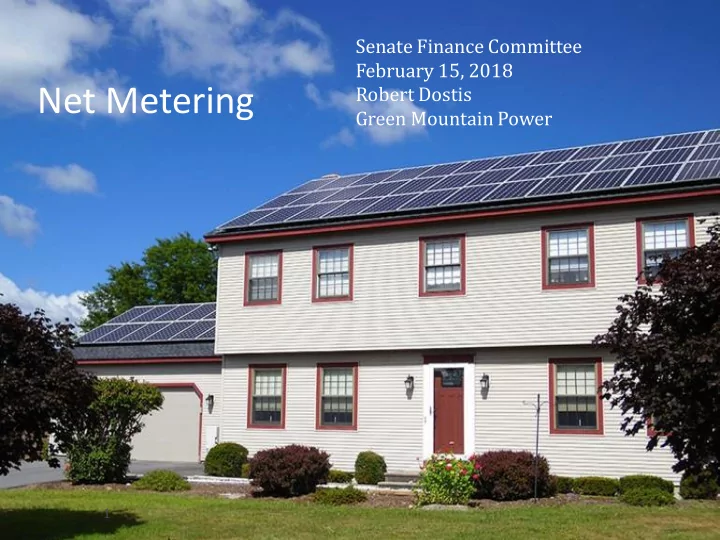

Senate Finance Committee February 15, 2018 Robert Dostis Net Metering Green Mountain Power 1
Net Metering – The Beginning Allowed customers to produce their own renewable electricity, generally rooftop Power produced went directly into the home or business Excess electricity was sent to the electric grid and “stored” If electricity produced was greater than what was used in a month the customers received a kilowatt hour credit towards their future bill If customer used more electricity than what they generated, they were billed for their “net” energy use 2
Net Metering Today 1,300% increase since 2013 Growth under NM 2.0 remains robust with 32.2 additional MW (= 4.6% of cap = Growth leader in U.S.) More than half of the capacity are 500 kw systems that are essentially stand-alone merchant generating plants Merchant generators receive the net meter rate, but Unlike traditional net metering (roof top/back yard): They send power directly to the grid rather than to a home or business They sell power to customers through PPA or contract They serve primarily commercial customers 3
2011: Act 47 -- The Vermont Energy Act of 2011 Net metering: Required all utilities to offer a solar adder setting total value at 20 cents/kWh. GMP in 2008 started with 6 cent “solar adder” equal to the value distributed solar provided Increased capacity of generators to 500 kW. (= 4 acres dev. ) Increased the cumulative net metering cap to 4%, or 28 MW for GMP.* Allowed net metering credits to be monetized, thus the kWh credit converted to dollars that can also cover non-energy parts of bill. Guaranteed incentive for ten years from installation. * GMP is presently at 183.8 MW of net metering; 178 is solar and = 26% of Peak Load; All Solar = 45% of peak load (Net metering 178 MW; and PPA; Standard Offer; GMP owned = 140.8)
2014: Act 99 Net Meter Changes Increased cap from 4%to 15% Allowed 5 MW solar on a closed landfills (Cost – see chart - total built 11 MW) Charged PUC to design program to balance pace of deployment with cost shift starting 1/1/2017 Project (12/4/17) Size (kW) Status Vermont Air National Guard (S Burlington) 2,100 Active National Guard Westminster 1,793 Active Brattleboro Landfill 4,980 In Construction South Burlington Landfill 1,764 Active 5
Accepted Net Metering in kilowatts / Year 60,000 <= 15 kW 50,000 > 15 kW, <= 150 kW 48,176 > 150 kW, <= 500 kW 40,000 Notice the robust growth in small net- Landfill/Military metered systems. 30,000 20,000 19,431 14,299 10,000 4,971 4,137 3,276 10,146 2,840 2,502 2,100 8,544 1,575 8,159 7,860 6,953 7,392 6,698 500 6,094 6,076 - 2012 2013 2014 2015 2016 2017 6
Net Metering 1.0 - Capacity and Volume 500 kw systems represent 47% (69.2 MW) of capacity and 2% of the application 150 kw systems represent 23% (33.1 MW) of capacity and 5% of the application 15 kw systems represent 30% (43.5 MW) of capacity and 93% of the application
Net Meter 2.0 – Capacity vs Applications 500 kw systems represent 52% (16.6 MW) of capacity and 2% of applications 150 kw systems represent 20% (6.6 MW) of capacity and 6% of applications 15 kw systems represent 28% (9.0 MW) of capacity and 92% of applications
Net Metering 2.0 Act 99 Resulted in Board Rule 5.100 – Effective 7/1/2017 PUC charged to support program growth while minimizing cost shift No impact to projects that received CPG prior to January 1, 2017 Limit Cost Shift Incentive levels were slightly reduced Siting: PUC identified “preferred sites,” such as brownfields. 150 kw systems get less if not on a preferred site. 500 kw can only be on preferred site. Starting in 2017 all new net metering projects are required to pay the customer service charge, energy efficiency charge, energy assistance program charge, any on-bill financing and equipment rental charges The total capacity of a single customer or group’s net metering systems may not exceed 500 kW 9
Success of Net Metering & Solar Programs Financial incentives and policy changes = 1,300 % increase • (184 MW in 2017 vs 13 MW in 2013) Total Solar = 317 MW • 178 MW Solar Net Metering • 139 MW other Solar (standard Offer, PPM, GMP) • GMP Average Daily Load = 475 MW • GMP Peak Load = 715 MW (1/14/17) • The penetration of distributed solar capacity is second only to • Hawaii More solar has diminishing value – peak has moved to evening • Customer cost impact for 2018 around $24 million •
Net Metering 1.0 & 2.0 NM 2.0 1,502 applications for 32.2 MW = ~ 4.6% of peak capacity
Solar in Vermont Incredible success story Important for our distributed energy future Cost-effective development is essential 12
Off takers of Group Net Metering Projects “Community Solar” 453 Project >15 kw: 250 only Commercial, 182 both, 19 only residential 13
Recommend
More recommend